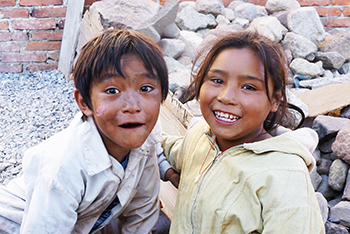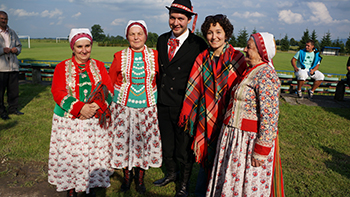About the Project
 Endangered languages. Comprehensive models for research and revitalization (grant of the National Program for the Development of Humanities [NPRH], 03.2013-03.2016; director: Justyna Olko)
Endangered languages. Comprehensive models for research and revitalization (grant of the National Program for the Development of Humanities [NPRH], 03.2013-03.2016; director: Justyna Olko)
Project’s website: http://www.revitalization.al.uw.edu.pl/

The project Endangered languages. Comprehensive models for research and revitalization is being carried out under my direction at the University of Warsaw, with the direct participation of the Instituto de Docencia e Investigación Etnológica de Zacatecas (IDIEZ), Adam Mickiewicz University and the Pedagogical University of Cracow, and in collaboration with the Wired Humanities Projects at the University of Oregon (Eugene) and the Universidad Autonóma de Tlaxcala. The project’s main aim is to construct a comprehensive, interdisciplinary model for research of endangered languages, closely linked to theoretical strategies and practical solutions for revitalization. The case studies include three endangered languages in two countries: Nahuatl in Mexico; and Lemko and Wymysiöeryś in Poland. This initiative integrates research communities in Poland and abroad. It's interdisciplinary and “cross-theme” collaborative model promotes cooperation among groups of people that normally don't work together, such as the academic world and local, educational and municipal organizations.
A multilingual internet site which was created during the course of the project (www.revitalization.al.uw.edu.pl) is being constantly expanded and updated with audiovisual resources, multimedia and research papers. The website offers a wide range of academic, educational and artistic resources to speakers of the targeted endangered languages, as well as to members of the broader public interested in researching and learning endangered languages. While it is still under development, parts are currently available in six different languages: Polish, English, Lemko, Wymysiöeryś, Nahuatl and Spanish. Furthermore, it has a complex structure in the form of specialized modules, dedicated to each of the three languages involved in this study, as well as a specific section on language revitalization. An important act of international collaboration implemented within the project was the founding of the Academia Wilamowicziana - Wymysiöeryś Akademyj (AWWA) in 2013. This initiative was designed to bring together native speakers of Wymysiöeryś, academics and activists in an international partnership with the goal of preserving the Wymysiöeryś language and promoting its official recognition as a regional language. Another important component of our work is the dissemination of Wilamowicean cultural and linguistic heritage in Poland and in Europe. An initial concrete step in this direction was the international conference dedicated to endangered language revitalization strategies, organized within the framework of this project in July 2014 in the town of Wilamowice. Another significant component of the research and educational activities was a Nahuatl Winter School, combined with the Second Interdialectal Encounter of Nahuatl in Cholula (Mexico), which I co-organized and co-led in collaboration with the Instituto de Docencia e Investigación Etnológica de Zacatecas (IDIEZ). Students from the United States, Mexico and Europe participated in the classes together with indigenous, Nahuatl-speaking youth from Tlaxcalancingo and Zoyatla. The Interdialectal Encounter, sponsored by the Comisión para el Desarrollo de los Pueblos Indígenas (6-19.01.2014), brought together seventy people, including speakers of local Nahuatl variants from all over Mexico.

The novelty of the project lies mainly in its model for collaboration with speakers of the studied languages. The traditional approach in ethnographic research has consisted in drawing a firm boundary between the informant (conceived of as a possessor of native cultural knowledge) and the anthropologist (the only participant capable of understanding and interpreting this knowledge at an academic level). The project attempts to deconstruct this boundary by assigning an active role to students and researchers who are members of the communities under investigation. Their participation helps to overcome certain limitations common to revitalization projects, such as the failure to recognize communities’ actual needs or the undervaluing of local attitudes towards language revitalization. Contact with speakers of the studied languages is established directly by different types of meetings, conferences and local events, and, on a wider scale, by means of this project’s website. It will gradually include many kinds of linguistic and cultural resources collected during the course of the project but, most importantly, it has been designed as a space available for writers in Nahuatl, Lemko and Wymysiöeryśto publish their works. Thus, our website is available in all three languages, as well as in Polish, Spanish and English, in order to enable as wide a public as possible to take advantage of the resources.
Another pioneering, boundary-crossing measure is our attempt to overcome the isolation of groups that struggle to preserve their languages. In spite of the fact that they originate in different environments, these three language communities share similar problems relating to administrative barriers, discrimination and marginalization. The project provides spaces for them to exchange and discuss common experiences. The original participants in the project also seek to include representatives of other endangered language communities in the seminars we carry out on a regular basis. This approach endeavors to raise the discussion from a local to a more global level. We believe that the revitalization of a language cannot be accomplished unless its speakers’ voices are heard within the context of a global cultural heritage. At the same time, the project encourages speakers of Nahuatl, Lemko and Wymysiöeryś to actively develop their language and extend its use into more and more sectors of modern culture and social life.
Last but not least, the project aims to make important contributions to scientific knowledge about the studied languages, compiling extensive documentation of both a historical (archival texts) and a contemporary (digital recordings) nature. Particular interest is given to tracing the process of linguistic change, especially that induced by contact with a dominant or neighboring culture, searching as far into the past with written sources, as possible. This aspect of the research facilitates the identification of vocabulary and linguistic structures that have fallen out of use, but may be reintroduced into the endangered language and thereby increase the resources that will allow it to serve as an efficient instrument of criticism, communication and creation in the ever-evolving contexts of modern life. The collected resources will also serve to expand and enrich already existing dictionaries, grammars and manuals.